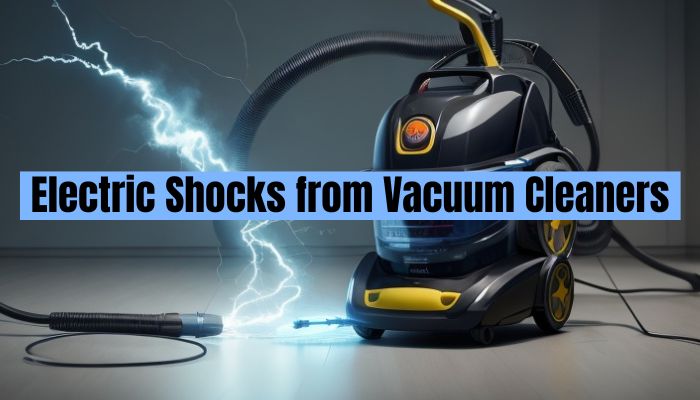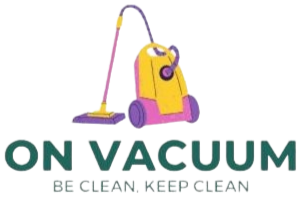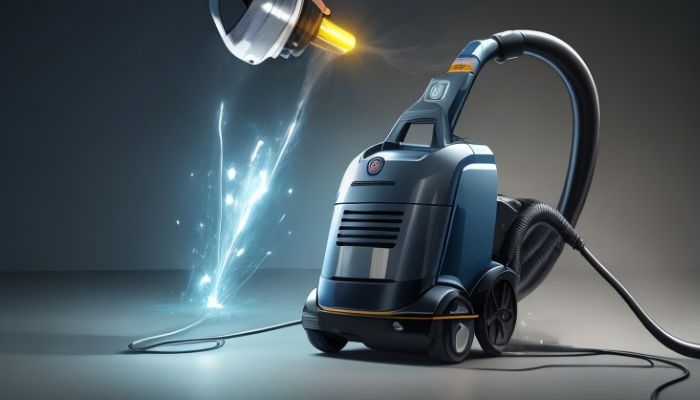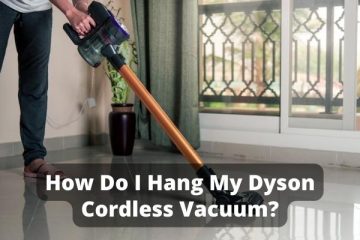Experiencing an electric shock from your vacuum cleaner? Delve deep into the reasons behind such incidents and learn the essential precautions to ensure your safety.
Bolded Heading: Understanding Electric Shocks from Vacuum Cleaners
Ever been vacuuming and felt a slight zap or tingle? Electric shocks from household appliances, including vacuum cleaners, can be startling and dangerous. But what causes these shocks? How do you avert such situations? Let’s zoom in for a better understanding.
Causes of Electric Shocks in Household Appliances
Several factors can lead to electric shocks in household gadgets:
- Faulty Wiring: Wires can become frayed or damaged over time, causing exposed sections that might come in contact with the device’s exterior.
- Lack of Grounding: Grounding, or earthing, is crucial in many electronic appliances. A device that isn’t grounded correctly can lead to electric shocks.
- Water Exposure: Water is a conductor. If any moisture gets into your device, it could cause a short circuit, leading to shocks.
- Internal Component Failure: Over time, parts inside the appliance can wear out or break, potentially leading to electrical issues.
Anatomy of a Vacuum Cleaner: Key Components
A vacuum cleaner, although simple in function, has multiple components:
- Motor: Generates suction by drawing air into the vacuum.
- Circuitry: Includes the device’s electrical components and wiring.
- Dustbin or Bag: Where the dust and dirt are stored.
- Hose and Nozzle: Helps direct the suction.
- Filter System: Ensures only clean air is expelled.
Any of these parts can develop faults over time or due to misuse, leading to potential electric shocks.
Read more about How Many Watts Does a Dyson Vacuum Use?
Identifying Faulty Wiring in Vacuum Cleaners
Detecting faulty wiring can prevent shocks. Here are signs to look out for:
- Exposed Wires: Check the cable for any signs of fraying or cuts.
- Sparks or Flickering: If you notice sparks or the vacuum’s power flickers, it might indicate a wiring issue.
- Burning Smell: A distinct burning odour could suggest the wire’s insulation is melting, indicating a short circuit.
- Inconsistent Operation: If your vacuum cleaner operates erratically, it may be due to a wiring fault.
Always consult a professional if you suspect wiring issues.
The Role of Grounding in Preventing Electric Shocks
Grounding plays a pivotal role in appliance safety. It ensures any unintended electrical current is directed safely into the ground, preventing shocks. If your vacuum has a three-prong plug, it’s grounded. Ensure it’s plugged into a three-hole outlet. Never remove the third prong, as it’s the grounding component.
Bolded Heading: Dangers of Using a Damaged Vacuum Cleaner Cord
A damaged vacuum cleaner cord isn’t just an inconvenience; it can be hazardous. Using a vacuum with a compromised cord can lead to the following:
- Electric Shocks: Exposed wires can easily zap you, especially if they come into contact with moisture.
- Short Circuits: Damaged wires can touch each other, causing a short circuit, damaging the vacuum, and posing a fire hazard.
- Fire Hazards: Besides short-circuiting, a damaged cord can produce sparks, which might ignite nearby flammable materials.
- Device Malfunction: Electrical inconsistencies can lead to erratic vacuum operation or failure.

Importance of Regular Vacuum Maintenance
Maintaining your vacuum isn’t just about ensuring it sucks up dirt effectively; it’s also about safety:
- Early Fault Detection: Regular inspections can help you spot issues like cord damage, faulty motors, or clogged filters before they become severe problems.
- Extend Lifespan: Well-maintained vacuums can last years longer than neglected ones, giving you better value for your money.
- Efficient Operation: A clean, well-functioning vacuum performs better, ensuring your floors are cleaner and improving indoor air quality.
- Save on Repairs: By addressing minor issues early, you can avoid costly repairs or replacements later on.
Top 5 Safety Tips to Avoid Electric Shocks
No one wants an electric shock during their cleaning routine. Here are five safety tips to ensure you stay zap-free:
- Inspect Before Each Use: Give your device a quick once-over before vacuuming. Look for any visible cord damage or other issues.
- Use Grounded Outlets: If your vacuum has a three-prong plug, plug it into a grounded outlet. This will divert any accidental surges safely.
- Avoid Moisture: Never vacuum up liquids or use your vacuum in a damp environment, as this increases the risk of electric shocks.
- Unplug by the Plug, Not the Cord: Pulling on the cord to unplug your vacuum can cause wear and tear. Instead, grasp the plug itself.
- Seek Professional Help: If you suspect any issues with your vacuum, don’t try to DIY a solution. Consult a professional for repairs.
Bolded Heading: Electric Shock Symptoms & First Aid Responses
Feeling the zap from home gadgets, like vacuum cleaners, can be both jarring and perilous. Being aware of the signs and equipped with the right response can be a lifesaver.
Symptoms of Electric Shock:
- Physical Marks: Burns or visible entry and exit wounds on the skin.
- Muscle Contractions: Involuntary jerking or stiffness.
- Breathing Issues: Difficulty catching breath or any respiratory distress.
- Cardiac Symptoms: Irregular heartbeats or cardiac arrest.
- Neurological Effects: Confusion, seizures, or even a loss of consciousness.
First Aid Responses:
- Turn Off the Electricity: If it’s safe, turn off the source of electricity.
- Call for Help: Dial emergency services immediately.
- Don’t Touch the Person: If they’re still in contact with the electrical source, touching them can electrify you too.
- Start CPR: If the person isn’t breathing, initiate CPR.
- Cover Burns: Use a sterile bandage or cloth to cover any burns lightly.
- Stay with the Person: Offer comfort and reassurance while waiting for professional medical assistance.
Real-life Incidents: Shocking Experiences Shared
- Jenny’s Tale: Jenny, a mother of two, was shocked by her old vacuum when she tried using it in her damp basement. She felt an immediate jolt and numbness in her arm but was luckily unhurt.
- Mark’s Story: Mark habitually yanked the cord to unplug his vacuum. One day, the frayed wires gave him a nasty shock, teaching him always to unplug devices gently.
Choosing Safe & Reliable Vacuum Cleaner Brands
Safety should always be a priority when purchasing household appliances. When it comes to vacuum cleaners, here’s how to pick a trustworthy brand:
- Check for Certifications: Look for safety certifications indicating that the product has been tested and meets specific safety standards.
- Read Reviews: Customer reviews can provide insights into the reliability and safety of a product.
- Avoid Extremely Cheap Models: While everyone loves a deal, exceptionally cheap vacuum cleaners might be cutting corners on safety.
- Prioritize Brands with Good Customer Service: Brands that value their customers are more likely to address safety concerns proactively.
- Always Register Your Product: This ensures you’ll be informed about any recalls or safety notices.
To wrap things up, electrical safety shouldn’t be taken lightly. From understanding the symptoms of electric shocks to choosing reliable and safe appliances, being informed and cautious is essential. After all, your safety and the safety of your loved ones should never be compromised.




